|
The Banjo and Guitar in Transition
Part 2
by Mike Daley
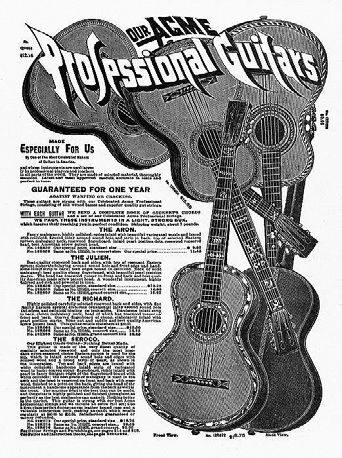
|
|
Sears Roebuck catalogue 1902
|
|
|
This article is a continuation of a two-part article on the changing uses of banjo and guitar, especially on early 78 RPM records and cylinders. Having covered the early history of the banjo and its use on some of the
first and most popular musical recordings, we'll look at the guitar and its appearances on early records, leading up to the 1930s. We'll focus on the American dance and jazz band scene and the changing uses of the
guitar during that time.
It is generally accepted by popular music historians that the guitar superseded the banjo, especially in urban dance and jazz bands, over the course of the late 1920s and early 1930s. This was a pivotal time in western popular culture, and the demise of the banjo and rise of the guitar was only one of several transformations taking place. Even so, the adoption of the guitar is emblematic of the new aesthetic that would dominate through the 1950s, when youth-oriented popular music, AKA rock 'n' roll, would begin its rise.
There are a number of reasons for the disappearance of the banjo from the mainstream, and the widespread adoption of the guitar. Advances in technology, economic factors, and cultural changes all had their role. But it was the brilliant work, on phonograph records and radio broadcasts, of a handful of prominent guitarists that spawned a generation of disciples and inspired a guitar culture that continues, and in fact grows bigger with every passing day.
The technique required to play a banjo is similar in many ways to the technique required to play a guitar. One may pluck with bare fingers, use metal or plastic fingerpicks or hold a flat, usually celluloid, pick or plectrum while playing either instrument. Both instruments have strings - usually six in the case of the guitar and four or five on the banjo. There is a strong similarity between the tuning scheme of the guitar and the five-string banjo. The four-string banjo is tuned more similarly to a violin or mandolin. With some adjustments, guitarists can "double" on banjo and vice versa. The biggest difference between the two instruments lies in the realm of tone colour.
The same note played on an acoustic guitar and a banjo will sound very different. When a string is plucked, energy is given to the tightened string - it is pulled off axis and released. A plucked string will produce a note with essentially two parts: an attack and a decay. Attack is the way that the note starts and decay is the way it dies off as the vibration of the string reduces through friction. Plucked strings tend to produce a loud attack and a fairly rapid decay. Where the guitar and the banjo differ is that the attack on the banjo is very loud and the decay is very quick, while the guitar has a more even loudness between the attack and the decay, and the decay is longer. This has to do with the very different construction of a guitar, which uses a wooden soundboard (the top of the guitar) for resonance, while a banjo uses an animal skin or drumhead stretched across a cut gourd or a circular frame made of wood or metal.
The distinct twang and hard, percussive attack of the banjo made it an ideal instrument for both unamplified stage performances and the acoustic recording process. As outlined in part 1, studio banjoists Vess L. Ossman and Fred Van Eps recorded hundreds of cylinders and discs with presumably healthy sales figures. But the "softer" attack and longer perceived note-length of the guitar gave single-note lines a certain smooth quality that suited the increasingly languid, polished dance music and jazz of the late 1920s and early 1930s. But the silky lines of contemporary popular guitarists like Eddie Lang would have been little heard if not for three technological developments of the 1920s: the Gibson L-5, the microphone and electrical recording.
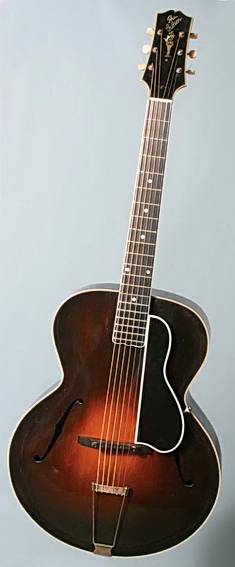
|
|
Gibson L-5 archtop guitar
|
|
|
Lloyd Loar (1886-1943) was a brilliant guitar and mandolin designer who worked for the Gibson guitar company from 1919 to 1924. In addition to his innovative mandolin designs, Loar developed the Gibson L-5 archtop guitar. This model incorporated a number of new features, including a longer neck, a "floating" fingerboard and "F"-shaped soundholes on the instrument top, similar to a violin. The L-5 produced a deep, loud tone that carried exceptionally well and could cut through a large dance orchestra without amplification. It is not an exaggeration to say that the L-5 became the founding design of the modern archtop guitar. Virtually all archtop guitars use some variation of Loar's creation; it is generally accepted that he "cracked the code" of archtop design. After Loar left Gibson in 1924, he struck out on his own with his ViviTone company, unsuccessfully experimenting with early electrostatic guitar pickups. The L-5 was adopted by guitarists ranging from the urbane Eddie Lang to the Carter Family's Maybelle Carter, who played in a banjo-influenced "clawhammer" style. The L-5 remains a flagship Gibson guitar model and is produced to this day. This guitar was increasingly heard through electrical microphones, as both recording and live music presentation were undergoing major change.
The history of the microphone starts in about 1861 with Johann Philipp Reis' "sound transmitter," a crude design that led to improvements by Thomas Edison and Emile Berliner among many others. By the mid-1920s, carbon microphones were in wide use, as well as new capacitor designs made possible by Lee de Forest's invention of the vacuum tube in 1907 (n.a.).
On stage, microphones began to appear in the middle of the 1920s. The first public-address (PA) system had been developed in 1915 by Peter L. Jensen, the founder of the Magnavox company. When the giant stateside firm American Telephone and Telegraph Company began to manufacture PAs in 1919 through Western Electric, some larger urban dance halls and nightclubs installed systems. Bands would typically have two microphones to work with; one for the singer or MC, and another for instrumental soloists who would approach the microphone as needed (ibid.). The portable guitar could easily be carried by a soloist, the microphone could be positioned in front of one or the other f-hole, and the warm tone of an archtop guitar could be easily heard above the other, naturally louder, instruments of the dance orchestra.
The advent of electrical recording brought microphone use into the recording studio. Eddie Lang cannily close-miked his guitar on his featured recordings; the result is a saturated, dark tone as heard on his rendition of Rachmaninoff's "Prelude Op. 3, No. 2" and "A Little Love, a Little Kiss," found on the two sides of Okeh 40989 (1927). Compare Nick Lucas' 1922 acoustic recordings of "Pickin' the Guitar" and "Teasing the Frets," found on Pathé Actuelle 020794. Lucas' guitar tone is thinner, lacking midrange richness; his picking is forceful, causing the strings to "twang" at times. Having cut his teeth in vaudeville theatres, playing his guitar without amplification, Lucas was clearly motivated to project. Lang tempered his pick attack; his approach is more gentle and relaxed. Perhaps Eddie Lang was the guitar equivalent of his employer Bing Crosby; both artists understood that the microphone obviated the need for the forceful performance approaches of the acoustic era and developed smooth, intimate styles that pointed the way to the future.
Economic factors also drove the guitar toward greater prominence in the early part of the 20th century. The Montgomery Ward and Sears Roebuck mail-order businesses made inexpensive, well-constructed guitars for the rural market starting in 1894. Thousands of instruments, selling for as low as $4.50 ($111.92 in today's money) were sent to aspiring and working guitarists all over the United States (Bradford 2009). Mail-order guitars were used by string bands, guitar evangelists, cowboys, songsters and blues musicians. For the itinerant musician, the guitar was portable, inexpensive and fairly easy to play.
The tremendous popularity of the minstrel show in the 19th century drove the widespread adoption of the banjo as an all-purpose rhythm and, sometimes, classical recital instrument. When the minstrel show began to fall out of fashion, the banjo fell with it. Blackface, once a generally accepted form of stage makeup that now stands as a metonym for the insulting, puerile stereotypes of the minstrel era, was quickly moving into the realm of nostalgia by the 1920s. The Jazz Singer, a tremendously popular film released in 1927, featured some famous Al Jolson numbers in which he wore blackface, including the iconic "Mammy." Blackface has been little seen in American movies since and is now a generally reviled period in the history of popular culture. The minstrel show tied the banjo to the plantation, the "Jim Crow" character and the awful history of slavery in the popular imagination.
Moreover, the banjo was the symbol of a bygone generation for the culturally dominant youth demographic of the 1920s. The young denizens of the Jazz Age saw their time as one with a decisive break from the period before World War One. Undoubtedly, the trauma of the Great War encouraged many to look with hope to a new age, post war. The Paul Whiteman Orchestra was, in some ways, emblematic of the new music; refined but light and hopeful, based on Tin Pan Alley with a nod to classical legitimacy. Though Whiteman retained Mike Pingatore as his longtime banjoist, he added Eddie Lang along with his violinist compadre Joe Venuti to the band in 1929. Lang and Venuti's explosive jazz episodes caused a sensation.
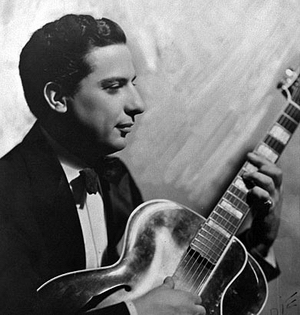
|
|
Eddie Lang
|
|
|
The entrance of jazz into the popular mainstream, beginning in 1917 with the hit Victor sides by the Original Dixieland Jazz Band, helped indirectly to bring attention to the guitar. The Okeh record company embraced the new music by skillfully recording the best New York musicians of the era. Okeh's recording director Tommy Rockwell was particularly prolific in his recording of Lang, along with fellow jazz pioneers Venuti, Bix Beiderbecke and Frankie Trumbauer. These classic recordings spread far and wide among jazz aficionados and musicians in the late 1920s and early 1930s.
Eddie Lang was born Salvatore Massaro in Philadelphia in 1902. Up to his early death from a botched tonsillectomy in 1933, Lang was one of the most-recorded guitarists of the period, the first call when guitar mastery was needed on a recording session. The son of a mandolin maker, he began on violin and met Joe Venuti in their elementary school orchestra. Lang began to work as a professional musician at 16 and switched to banjo and then guitar. He joined the Mound City Blue Blowers soon after relocating to New York City, and toured Europe with them in 1924. On his early sides with the Blue Blowers, especially "Deep Second Street Blues" (Brunswick 2804), Lang evinces harmonic sophistication, fleet lines and an innate rhythmic sense.
Lang quickly became the most sought-after guitarist in New York. He was contracted by dance band leaders Roger Wolfe Kahn, Jean Goldkette and the king of them all (if not of jazz), Paul Whiteman. Beginning in 1926, he made some pioneering duo records with Joe Venuti, notably "Black and Blue Bottom" (Columbia 914-D) and "Wild Cat" (Okeh 40762). These records undoubtedly laid the blueprint for the intuitive partnership of Django Reinhardt and Stephane Grappelli, listening in Paris to Parlophone pressings of the duo.
When he died in early 1933, Lang was the favored accompanist of Bing Crosby, who would become one of the biggest entertainment figures of Western popular culture. But Lang's most famous and enduring performance is the Frankie Trumbauer and his Orchestra version of "Singin' the Blues" (Okeh 40772). His clever accompaniment, alternating chords with single notes, includes some fleet melodic interjections that complement perfectly the solos of Bix, Tram and the rest. Over the course of his short career, Lang recorded in the company of a who's who of 1920s jazz greats, including Bix, Louis Armstrong, Adrian Rollini, Jack Teagarden and his contemporary Lonnie Johnson.
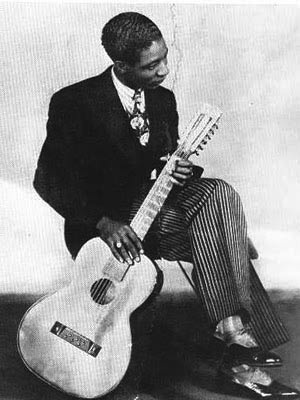
|
|
Lonnie Johnson
|
|
|
Lonnie Johnson (1899-1970) was a fluid guitarist now mostly remembered for his blues vocal hits, including "Tomorrow Night" from 1950. But it is not as well recalled today that Johnson did much to advance the sound of the single-string guitar solo in the mid-1920s. He appeared on 1927 records by Louis Armstrong's Hot Five - "I'm Not Rough" (Okeh 8551), "Savoy Blues" (Okeh 8535) and "Hotter Than That" (same) and as a featured soloist with Duke Ellington and his Famous Orchestra on "Hot and Bothered" (Okeh 8623), "Move Over" (Okeh 8683) and "The Mooche" (Okeh 8623). But his most memorable 1920s work must be his masterful jazz-blues duets with Eddie Lang. Their ten duet sides were recorded in late 1928 and early 1929 for Okeh. Lang's pseudonym, "Blind Willie Dunn," was a sobriquet presumably intended to assuage any suspicions about musical miscegenation. In any case, all of the 78 RPM reissues on Parlophone (England) and Odeon (Germany) credited the duo as Ed Lang and Lonnie Johnson.
The Great Depression largely curtailed the kind of chamber jazz that best showcased the talents of what was still a strictly acoustic instrument. But the period from about 1932 to 1936 saw the gradual adoption of the guitar as the rhythm instrument of choice, and the final decline of the banjo. The guitar was widely used through the years 1932-1936 as a robust rhythm instrument, typically working in tandem with the drummer in creating a seamless, urbane swing. This was not dissimilar to the banjo's usual role in bands up to that time - two or four even chord strokes to the bar. Freddie Green, Count Basie's longtime guitarist, is the best remembered today of the hundreds of swing-era rhythm guitarists. The players uniformly employed Gibson, Epiphone, Stromberg and D'Angelico archtop acoustic guitars. These guitars projected a harmonic undertone that served the rhythmic bed of the big band.
Eddie Durham, a well-known trombonist and arranger who worked with the Basie band, Cab Calloway, Andy Kirk, Jimmy Lunceford and others, was also among the first electric guitarists to record. He had earlier tried to amplify his guitar with homemade resonator cones and using the National steel-bodied resonator guitars, which were manufactured starting in 1926 and were the loudest guitars of the time. His electrified solos, played on Basie's seminal Kansas City Five and Kansas City Six session in 1936, point to a new conception of the guitar that exploits the sonic idiosyncrasies of the electric guitar and its new companion, the squat, leather-covered wooden cabinet that combined a speaker and a rudimentary tube amplifier - the "amp."
The magnetic guitar pickup is the heart of the electric guitar - it allows for the theoretically limitless amplification of the sound of a guitar using a loop of copper wire wrapped hundreds of times around a bobbin that contains either six magnets, one for each string, or one long "blade" magnet. This pickup is mounted on the body of the guitar, with the magnet(s) about a half inch or less away from the strings. The magnets create a magnetic field around the strings which is disturbed by the movement of the strings. This disturbance is converted into electrical information, which is sent through a shielded copper-strand cable, and converted into sound by the amplifier. Along the way, the signal can be reduced in volume or timbrally altered with onboard knobs and switches that control potentiometers and resistors.

|
|
Rickenbacker "Frying Pan" electric lap steel guitar
|
|
|
The lap steel guitar was the first beneficiary of magnetic pickup technology. Lap steel is a way of playing a guitar where the musician places the guitarist on his or her lap and slides a steel or plastic bar across the strings to create sliding, crying melodies and accompaniments. The lap steel guitar was an important part of both early country music and the very popular Hawai'ian style. Rickenbacker, then known as the Electro String Instrument Company, manufactured an electrified steel as early as 1931. This instrument was later nicknamed "The Frying Pan" for its resemblance to that kitchen implement.
The first Spanish electric guitar ("Spanish" was the designation for a conventional guitar, played by pressing the strings onto the neck) to reach wide use was the Gibson ES-150, introduced in 1936. This guitar, with its single-blade magnet pickup, was the best constructed and best sounding electric guitar of the era, and its smooth, deep sound was to define the sound of early electric guitar. It was adopted by both Durham and the Oklahoma-born guitarist Charlie Christian. Though Durham has pride of place as an electric guitar pioneer, it was the brilliant, forward-looking Christian who was to firmly establish the electric guitar as a jazz instrument. In his tragically short life, he also managed to help develop a new way of improvising that was to take the name bebop not long after his death from tuberculosis in 1942.
Christian's creative single-note soloing used the thick, slightly distorted tone of his Gibson ES-150 and small (by today's standards) Gibson amplifier to craft a horn-like sound that allowed him to soar above the sound of the rhythm section. His extended solos on Benny Goodman Sextet sides of the early 1940s like "Till Tom Special", "Breakfast Feud" and "Seven Come Eleven" were widely studied by young acolytes like Herb Ellis, Barney Kessel and Tal Farlow. These men were among those who would firmly establish the sound of the guitar in the small jazz ensembles of the 1950s.
By the 1950s, the electric guitar was a primary instrument of rock 'n' roll. This alone would assure its continued popularity, but rock 'n' roll in its first iterations was little different from the 1940s rhythm and blues of Louis Jordan, Wynonie Harris and others. What was significant was that this jumpy style was being successfully marketed to children and teenagers. The boom of this demographic after World War II and their relative affluence guaranteed that the simplified lyrics and highly rhythmic, sometimes raunchy sound of rock 'n' roll were here to stay.
Rock 'n' roll heroes like Elvis Presley, Buddy Holly and Chuck Berry wielded acoustic and electric guitars to great effect, especially on television. At this time the visual cult of the guitar, begun by movie cowboys like Gene Autry and Roy Rogers, was considerably advanced and the guitar became a popular teenage pastime. This was a the foundation of the new form of amateur music making, suited to the decline of formal music education and the piano as the entertainment centre of the middle-class American home. Because a few chord forms can suffice to render thousands of simple popular songs, the guitar has become the instrument of choice among amateur musicians. Inexpensive guitars from China, Indonesia and Mexico have flooded the market, making the acquisition of a guitar and amplifier of reasonable quality easier than ever. The guitar, both acoustic and electric, has been adopted in popular music all over the world.
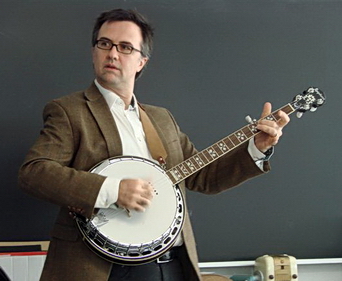
|
|
Mike Daley
(photo courtesy Arthur Zimmerman)
|
|
|
The banjo occupies a smaller place in contemporary popular culture. It is largely associated in the modern mind with hillbilly stereotypes, Steve Martin's comedy routines and "Dueling Banjos" (along with the indelible hillbilly horror of "Deliverance"). But in some quarters, the banjo is on the rise. Young folk-pop bands like Mumford and Sons have lately incorporated the five-string banjo as an important part of their "retro" instrumentation. A strong amateur five-string banjo scene is largely based around the bluegrass banjo style of Earl Scruggs and his disciples. A less prominent strain of five-string banjo playing follows the melodic style of Bill Keith. Standout soloists like Bela Fleck and Noah Pikelny have taken banjo into highly creative and diverse territory, with classical and modern jazz-pop forays. The four-string tenor banjo continues to be the fretted stringed instrument of choice in Dixieland jazz ensembles. Some guitarists switch to a guitar-based tuning when playing the tenor banjo, a practice commonly referred to by purists as "fanjo" - fake banjo.
The decline of the banjo and the rise of the guitar in the 1920s and 1930s had much to do with changing social mores around race, advancing technology in guitarmaking and the work of some pioneering musicians. All three of these factors have played a major role in the continued (and seemingly always increasing) popularity of the guitar. But the banjo is seeing a small but significant rise in popularity, aided by strong interest among the demographically significant "millenial" generation, the children of the baby boomers. The widespread adoption of the internet has had the effect of connecting and strengthening niche communities, like amateur banjoists. Websites like The Banjo Hangout (<>) draw together banjo enthusiasts across the earth to share musical recommendations, playing tips, and technical information about banjo purchasing and upkeep. The banjo, defeated by the guitar in the mainstream, holds its own today. But negative stereotypes die hard and the banjo is unlikely to re-take center stage anytime soon.
Sources:
|